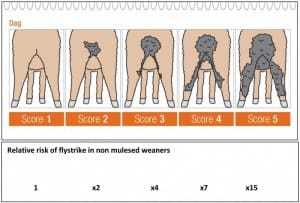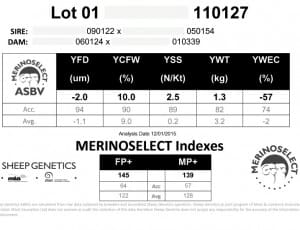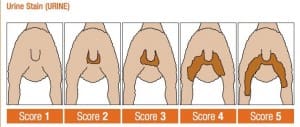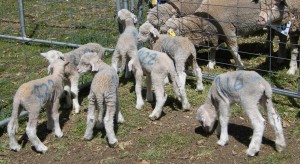Sheep resistant to worms and flystrike can make flock management easier for Australian producers, but not enough flocks are using the range of genetic and visual ranking tools available.
Breeders have found selecting sheep for low wrinkle, fleece rot and dag scores in relevant regions, and using Australian Sheep Breeding Values (ASBVs), can reduce the incidence of blowfly strike over time, according to industry flystrike control website FlyBoss.
A survey of about 1000 producers in 2011, showed that 45pc of respondents were using visual selection to reduce susceptibility of rams to blowfly strike. The most common methods were selection of plain bodied sheep, low breech wrinkle, low fleece rot score and culling sheep that experienced body or breech strike.
But only 10pc of survey respondents used ASBVs to reduce susceptibility to blowfly strike, with the most commonly used traits reported as being low coefficient of variation of fibre diameter (also used for staple strength improvement), low breech wrinkle and low dag score.
 Only 13pc of survey respondents used rams selected for resistance to worms, and only 62pc of these rams were selected on the basis of the ASBV for worm egg count or WEC.
Only 13pc of survey respondents used rams selected for resistance to worms, and only 62pc of these rams were selected on the basis of the ASBV for worm egg count or WEC.
Genetic tool uptake is low
ParaBoss executive officer Lewis Kahn believes the uptake of flystrike related and worm resistance tools might have increased since the surveys, but the number of commercial producers using genetic tools for the traits is still “way too low”.
“The industry is not using all the tools available to make the genetic progress in animal health traits that it could,” he said.
“What we are trying to do is constantly raise the issue that you can’t see whether a ram is wormy or not, you’ve got to use figures.”
ParaBoss operations manager Deb Maxwell said many farmers have moved out of sheep because they are sick of chasing worms and flies.
“But effective management of these parasites does not have to be so hard.
“Breeding for both worm and flystrike resistance is one way many producers have already made substantial savings to their time and
treatment costs, as well as improving animal welfare.”
Urine stain is key attractor for flies
Ms Maxwell said the the FlyBoss web site has just been updated with the latest information from the AWI Breech Strike Project on
breeding for flystrike resistance, including recent research that shows urine stain is a heritable trait.
But Dr Kahn said more needs to be understood about it before it can be recommended in a breeding program.
“Objective selection for fly and worm resistance has been mainstream now for years on quite a few studs.
“This means that there are rams available with a very high level of resistance compared to 10 years ago.
“So, while genetic selection doesn’t happen overnight, the improvement in one generation these days can be surprising, if the right rams are chosen,“ Dr Kahn said.
Urine stain is a key attractor for flies and producers are advised to consider culling all ewe lambs with score 5 for urine stain at weaning after identification at marking. Observations on fine wool sheep in the summer rainfall environment show that urine stain is associated with wrinkle to a fair degree, so reducing wrinkle and wool cover will indirectly help with urine stain.
Urine stain has also been shown to be more heritable in the WA breech strike research flock (based at DAFWA, Mt Barker) than the Armidale breech strike research flock (based at CSIRO, Armidale).
Petali is using ASBVs for WEC and growth
Petali Merino and White Suffolk stud breeder Martin Oppenheimer at Walcha said he had been using ASBVs for WEC and early growth to select sheep that were resistant to worms and resilient enough to survive and grow in a wormy environment.
“If they have a low worm egg count in a wormy environment, but are still able to grow at a high rate (daily weight gains of 300gms+ for White Suffolks and 250gms+ for Merinos) in a wormy environment that means they are resilient.”
Conditions have been dry for the past three years with lower than normal WECs, but still with wet and warm summer and autumn, Petali’s flock Merino maiden ewes did not have a drench for at least 15 months at a 16DSE per hectare stocking rate achieving a 110pc lambing and fleece weights with “virtually no losses.”
“They had a drench as yearlings and then they didn’t have a drench until they weaned their first lamb.
“So they went from August 2013 through to January 2015 without having any treatment,” he said.
“It was a drier than normal year, but for us that was a pretty extraordinary occurrence.”
Concurrent selection for better post-weaning growth in Merinos and the terminal flock was leading to less weaner ill-thrift through autumn and winter up to shearing, he said.
“It makes when turning off prime lambs and of course, the Merino (wethers and cull ewe lambs) lambs are virtually prime lambs anyway.”
Petali was using less chemicals on the body of sheep for flystrike and since 2005 all Merino stud lambs have been scored for breech wrinkle and cover. Sheep have been scored for dag for the past four years.
Management gains from breech wrinkle selection could be made in a few years, he said. But gains were more easily obtained among balanced plain-bodied, high growth and fertility sheep with heavy fleeces, and less so among “over-woolled” super-heavy fleece weight sheep with more skin development, he said.
“A plain body is part of our target type, so on an ASBV level, our target for clean fleece weight is around +25, and if were to go to +30 or +40, and there are some of those sheep around in the industry, they will struggle with breech wrinkle.”
SuperBorder breeder didn’t drench for two years
South Australian SuperBorder breeder Lynton Arney said progress in selecting for low WEC animals using ASBVs was slow after 15 years, but faecal monitoring was important to get a full picture of worm loads.
“You can have low WEC animals with dags, so it is one of those things that takes time to really put the picture together.”
But he was drenching less and worm egg counts were down this year, though this depended on the season.
“We have actually got through two consecutive years without drenching the rams that we had for sale, because they didn’t have any worms.
“But that was very detrimental to us in that we didn’t get to collect any data from those animals in those years, because the worm egg levels weren’t high enough to collect samples to put into the system.”
The DNA information needed to match with physical worm counts was not yet available, but testing as many animals as possible for WEC back into pedigrees is the only way to get reliability and to compensate for variation in WEC between animals, he said.
Use rams with low ASBVs for WEC, breech wrinkle and dag
 Dr Kahn said when choosing rams using performance and visual data, producers should look for rams with lower ASBVs for worm egg count, breech wrinkle and dag (in scour worm areas). If they are not available, they can ask stud breeders to start providing these.
Dr Kahn said when choosing rams using performance and visual data, producers should look for rams with lower ASBVs for worm egg count, breech wrinkle and dag (in scour worm areas). If they are not available, they can ask stud breeders to start providing these.
“A flock more resistant to worms decreases the number of worm larvae on pasture and increases the time before lost production becomes significant.
“This means fewer drenches, which not only saves time, but helps to preserve drench effectiveness on your farm. It also means fewer deaths in those regions where Barber’s Pole can be a problem,” Dr Kahn said.
“When it comes to flystrike, focus on reducing fleece rot, as it is the main cause of body strike.
Dr Kahn said for breech strike, the first priority is to reduce breech wrinkle and also dag where it is common.
“However, wait until breeches are quite plain before selecting for reduced breech cover.”
Dr Kahn said there is only so much emphasis that can be placed on flystrike.
“Other traits are important too, and wrinkle can be reduced much faster than breech cover, so it achieves the fastest benefits.”
ParaBoss operates WormBoss, FlyBoss and LiceBoss for Australian sheep producers, providing information and tools for parasite management including practical strategies to breed for worm and flystrike resistance. The monthly ParaBoss e-News provides state updates and articles on worms, flies and lice.
For more information: www.paraboss.com.au.



HAVE YOUR SAY